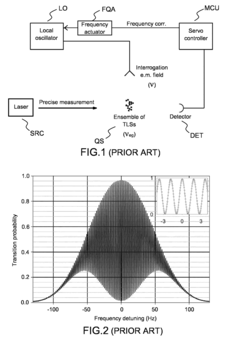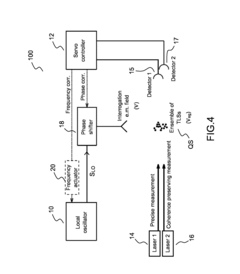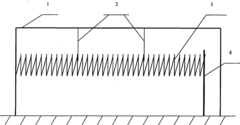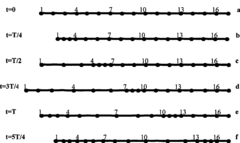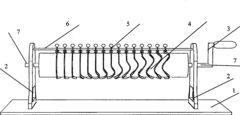Longitudinal wave methodologies in astronomical observatory operations
AUG 13, 20259 MIN READ
Generate Your Research Report Instantly with AI Agent
Patsnap Eureka helps you evaluate technical feasibility & market potential.
Astronomical Waves: Background and Objectives
Longitudinal waves have played a crucial role in astronomical observations since the early days of radio astronomy. These waves, characterized by oscillations parallel to the direction of wave propagation, have been instrumental in probing the depths of the universe and unraveling its mysteries. The study of longitudinal wave methodologies in astronomical observatory operations has evolved significantly over the past century, driven by technological advancements and our growing understanding of cosmic phenomena.
The primary objective of researching longitudinal wave methodologies in astronomical observatory operations is to enhance our ability to detect, analyze, and interpret signals from distant celestial objects. This research aims to improve the sensitivity, resolution, and accuracy of astronomical observations, ultimately leading to groundbreaking discoveries in astrophysics and cosmology.
One of the key areas of focus in this field is the development of advanced radio telescopes and interferometry techniques. These technologies leverage the properties of longitudinal waves to create high-resolution images of celestial objects and measure their physical properties with unprecedented precision. The Square Kilometre Array (SKA) project, for instance, represents a significant milestone in this endeavor, promising to revolutionize our understanding of the universe through its unparalleled sensitivity and survey speed.
Another critical aspect of longitudinal wave research in astronomy is the study of gravitational waves. These ripples in spacetime, predicted by Einstein's theory of general relativity, were first directly detected in 2015, opening up an entirely new field of gravitational wave astronomy. The detection and analysis of gravitational waves rely heavily on the principles of longitudinal wave propagation and interferometry, showcasing the broad applicability of these methodologies in modern astronomical research.
The exploration of cosmic microwave background radiation (CMB) is yet another area where longitudinal wave methodologies play a pivotal role. By studying the subtle variations in this ancient light, astronomers can glean insights into the early universe and test fundamental theories of cosmology. Advanced instruments like the Planck satellite have utilized sophisticated longitudinal wave detection techniques to map the CMB with extraordinary precision, providing crucial data for understanding the origin and evolution of the universe.
As we look to the future, the continued advancement of longitudinal wave methodologies in astronomical observatory operations holds immense promise. Emerging technologies such as quantum sensors and novel materials for wave detection are poised to push the boundaries of what is possible in astronomical observations. These developments may lead to the detection of previously unobservable phenomena, such as dark matter and dark energy, and provide new insights into the fundamental nature of the universe.
The primary objective of researching longitudinal wave methodologies in astronomical observatory operations is to enhance our ability to detect, analyze, and interpret signals from distant celestial objects. This research aims to improve the sensitivity, resolution, and accuracy of astronomical observations, ultimately leading to groundbreaking discoveries in astrophysics and cosmology.
One of the key areas of focus in this field is the development of advanced radio telescopes and interferometry techniques. These technologies leverage the properties of longitudinal waves to create high-resolution images of celestial objects and measure their physical properties with unprecedented precision. The Square Kilometre Array (SKA) project, for instance, represents a significant milestone in this endeavor, promising to revolutionize our understanding of the universe through its unparalleled sensitivity and survey speed.
Another critical aspect of longitudinal wave research in astronomy is the study of gravitational waves. These ripples in spacetime, predicted by Einstein's theory of general relativity, were first directly detected in 2015, opening up an entirely new field of gravitational wave astronomy. The detection and analysis of gravitational waves rely heavily on the principles of longitudinal wave propagation and interferometry, showcasing the broad applicability of these methodologies in modern astronomical research.
The exploration of cosmic microwave background radiation (CMB) is yet another area where longitudinal wave methodologies play a pivotal role. By studying the subtle variations in this ancient light, astronomers can glean insights into the early universe and test fundamental theories of cosmology. Advanced instruments like the Planck satellite have utilized sophisticated longitudinal wave detection techniques to map the CMB with extraordinary precision, providing crucial data for understanding the origin and evolution of the universe.
As we look to the future, the continued advancement of longitudinal wave methodologies in astronomical observatory operations holds immense promise. Emerging technologies such as quantum sensors and novel materials for wave detection are poised to push the boundaries of what is possible in astronomical observations. These developments may lead to the detection of previously unobservable phenomena, such as dark matter and dark energy, and provide new insights into the fundamental nature of the universe.
Market Analysis: Observatory Demand
The demand for advanced longitudinal wave methodologies in astronomical observatory operations has been steadily increasing in recent years. This growth is driven by the need for more precise and efficient data collection techniques in observatories worldwide. As astronomical research continues to push the boundaries of our understanding of the universe, observatories are seeking innovative solutions to enhance their operational capabilities and data quality.
The global market for astronomical observatories is projected to expand significantly over the next decade. This growth is fueled by increasing investments in space exploration, the search for exoplanets, and the study of cosmic phenomena. Governments, research institutions, and private organizations are allocating substantial resources to upgrade existing facilities and construct new state-of-the-art observatories.
Longitudinal wave methodologies play a crucial role in improving the accuracy and resolution of astronomical observations. These techniques are particularly valuable in mitigating atmospheric disturbances, enhancing signal-to-noise ratios, and enabling more precise measurements of celestial objects. As a result, observatories are actively seeking advanced longitudinal wave solutions to maintain their competitive edge and contribute to groundbreaking scientific discoveries.
The demand for these technologies is not limited to large-scale observatories. There is a growing trend towards smaller, more distributed observatory networks that require efficient and cost-effective longitudinal wave systems. This trend is creating new market opportunities for technology providers and researchers in the field.
Geographically, the demand for longitudinal wave methodologies in observatories is global, with significant interest from North America, Europe, and Asia-Pacific regions. Countries with established astronomical research programs, such as the United States, Germany, and Japan, are leading the adoption of these technologies. However, emerging markets in South America, Africa, and the Middle East are also showing increased interest as they develop their astronomical research capabilities.
The market is further driven by the need for improved data processing and analysis techniques. As observatories generate increasingly large volumes of data, there is a growing demand for advanced longitudinal wave methodologies that can efficiently process and interpret this information. This trend is creating opportunities for interdisciplinary collaborations between astronomers, physicists, and data scientists.
In conclusion, the market for longitudinal wave methodologies in astronomical observatory operations is poised for significant growth. The combination of technological advancements, increasing research funding, and the expanding scope of astronomical studies is creating a robust demand for innovative solutions in this field. As observatories continue to evolve and adapt to new scientific challenges, the market for longitudinal wave technologies is expected to remain dynamic and offer substantial opportunities for development and innovation.
The global market for astronomical observatories is projected to expand significantly over the next decade. This growth is fueled by increasing investments in space exploration, the search for exoplanets, and the study of cosmic phenomena. Governments, research institutions, and private organizations are allocating substantial resources to upgrade existing facilities and construct new state-of-the-art observatories.
Longitudinal wave methodologies play a crucial role in improving the accuracy and resolution of astronomical observations. These techniques are particularly valuable in mitigating atmospheric disturbances, enhancing signal-to-noise ratios, and enabling more precise measurements of celestial objects. As a result, observatories are actively seeking advanced longitudinal wave solutions to maintain their competitive edge and contribute to groundbreaking scientific discoveries.
The demand for these technologies is not limited to large-scale observatories. There is a growing trend towards smaller, more distributed observatory networks that require efficient and cost-effective longitudinal wave systems. This trend is creating new market opportunities for technology providers and researchers in the field.
Geographically, the demand for longitudinal wave methodologies in observatories is global, with significant interest from North America, Europe, and Asia-Pacific regions. Countries with established astronomical research programs, such as the United States, Germany, and Japan, are leading the adoption of these technologies. However, emerging markets in South America, Africa, and the Middle East are also showing increased interest as they develop their astronomical research capabilities.
The market is further driven by the need for improved data processing and analysis techniques. As observatories generate increasingly large volumes of data, there is a growing demand for advanced longitudinal wave methodologies that can efficiently process and interpret this information. This trend is creating opportunities for interdisciplinary collaborations between astronomers, physicists, and data scientists.
In conclusion, the market for longitudinal wave methodologies in astronomical observatory operations is poised for significant growth. The combination of technological advancements, increasing research funding, and the expanding scope of astronomical studies is creating a robust demand for innovative solutions in this field. As observatories continue to evolve and adapt to new scientific challenges, the market for longitudinal wave technologies is expected to remain dynamic and offer substantial opportunities for development and innovation.
Longitudinal Wave Tech: Current State
Longitudinal wave methodologies have become increasingly significant in astronomical observatory operations, offering unique advantages in data collection and analysis. The current state of this technology reflects a dynamic field with ongoing advancements and challenges.
At present, longitudinal wave techniques are primarily employed in radio astronomy and gravitational wave detection. In radio astronomy, these methods enable the precise measurement of celestial object distances and velocities through Doppler shift analysis. The technology has evolved to incorporate advanced signal processing algorithms and high-sensitivity receivers, allowing for the detection of extremely faint radio emissions from distant galaxies and other cosmic phenomena.
Gravitational wave observatories, such as LIGO and Virgo, utilize longitudinal wave principles to detect minute spacetime distortions caused by massive cosmic events. These facilities have achieved remarkable sensitivity, capable of measuring displacements smaller than the diameter of an atomic nucleus. Recent upgrades have further enhanced their capabilities, expanding the observable range of gravitational wave sources.
One of the key technological advancements in longitudinal wave methodologies is the development of quantum-limited detectors. These cutting-edge devices approach the fundamental limits of measurement precision imposed by quantum mechanics, significantly improving signal-to-noise ratios in astronomical observations. Superconducting quantum interference devices (SQUIDs) and optomechanical sensors are at the forefront of this innovation, pushing the boundaries of detection sensitivity.
Data processing and analysis techniques have also seen substantial progress. Machine learning algorithms and artificial intelligence are increasingly being integrated into longitudinal wave data analysis pipelines, enabling more efficient signal extraction and noise reduction. These computational advancements have led to the discovery of previously undetectable astronomical phenomena and have improved the overall reliability of observational data.
However, the field faces several challenges. Atmospheric disturbances and terrestrial noise sources continue to pose significant obstacles for ground-based observatories. Efforts to mitigate these issues include the development of adaptive optics systems and the exploration of space-based observatories, which promise to eliminate atmospheric interference entirely.
Furthermore, the integration of longitudinal wave methodologies with other observational techniques, such as multi-messenger astronomy, is an area of active research. This interdisciplinary approach aims to combine data from various types of astronomical observations to gain a more comprehensive understanding of cosmic events.
In conclusion, the current state of longitudinal wave technology in astronomical observatory operations is characterized by rapid advancement and innovation. While significant progress has been made in detection sensitivity and data analysis, ongoing challenges drive continued research and development in this field.
At present, longitudinal wave techniques are primarily employed in radio astronomy and gravitational wave detection. In radio astronomy, these methods enable the precise measurement of celestial object distances and velocities through Doppler shift analysis. The technology has evolved to incorporate advanced signal processing algorithms and high-sensitivity receivers, allowing for the detection of extremely faint radio emissions from distant galaxies and other cosmic phenomena.
Gravitational wave observatories, such as LIGO and Virgo, utilize longitudinal wave principles to detect minute spacetime distortions caused by massive cosmic events. These facilities have achieved remarkable sensitivity, capable of measuring displacements smaller than the diameter of an atomic nucleus. Recent upgrades have further enhanced their capabilities, expanding the observable range of gravitational wave sources.
One of the key technological advancements in longitudinal wave methodologies is the development of quantum-limited detectors. These cutting-edge devices approach the fundamental limits of measurement precision imposed by quantum mechanics, significantly improving signal-to-noise ratios in astronomical observations. Superconducting quantum interference devices (SQUIDs) and optomechanical sensors are at the forefront of this innovation, pushing the boundaries of detection sensitivity.
Data processing and analysis techniques have also seen substantial progress. Machine learning algorithms and artificial intelligence are increasingly being integrated into longitudinal wave data analysis pipelines, enabling more efficient signal extraction and noise reduction. These computational advancements have led to the discovery of previously undetectable astronomical phenomena and have improved the overall reliability of observational data.
However, the field faces several challenges. Atmospheric disturbances and terrestrial noise sources continue to pose significant obstacles for ground-based observatories. Efforts to mitigate these issues include the development of adaptive optics systems and the exploration of space-based observatories, which promise to eliminate atmospheric interference entirely.
Furthermore, the integration of longitudinal wave methodologies with other observational techniques, such as multi-messenger astronomy, is an area of active research. This interdisciplinary approach aims to combine data from various types of astronomical observations to gain a more comprehensive understanding of cosmic events.
In conclusion, the current state of longitudinal wave technology in astronomical observatory operations is characterized by rapid advancement and innovation. While significant progress has been made in detection sensitivity and data analysis, ongoing challenges drive continued research and development in this field.
Existing Longitudinal Wave Solutions
01 Acoustic wave propagation and analysis
Longitudinal wave methodologies involve techniques for generating, propagating, and analyzing acoustic waves in various media. These methods are used for non-destructive testing, material characterization, and structural health monitoring. Advanced signal processing algorithms are employed to extract meaningful information from the wave propagation data.- Acoustic wave propagation and analysis: Longitudinal wave methodologies involve techniques for generating, propagating, and analyzing acoustic waves. These methods are used in various applications such as ultrasound imaging, non-destructive testing, and seismic exploration. The approaches focus on optimizing wave generation, improving signal processing, and enhancing the interpretation of wave data for better accuracy and resolution.
- Longitudinal wave-based imaging systems: Imaging systems utilizing longitudinal waves are developed for medical diagnostics, industrial inspections, and geological surveys. These systems employ advanced transducer designs, beamforming techniques, and signal processing algorithms to create high-resolution images of internal structures. The methodologies focus on improving image quality, reducing artifacts, and enhancing the overall performance of wave-based imaging systems.
- Longitudinal wave sensors and detectors: Sensors and detectors based on longitudinal wave principles are designed for various applications, including structural health monitoring, material characterization, and environmental sensing. These devices utilize innovative materials, transducer configurations, and signal processing techniques to improve sensitivity, accuracy, and reliability in detecting and measuring longitudinal wave phenomena.
- Communication systems using longitudinal waves: Communication methodologies leveraging longitudinal waves are developed for underwater, underground, and through-wall applications. These systems exploit the propagation characteristics of longitudinal waves to transmit data in challenging environments where traditional electromagnetic waves are ineffective. The approaches focus on modulation techniques, channel modeling, and noise reduction to improve communication range and data rates.
- Longitudinal wave energy harvesting and manipulation: Methodologies for harvesting and manipulating longitudinal wave energy are explored for applications in energy generation, acoustic cloaking, and wave steering. These techniques involve the design of metamaterials, phononic crystals, and adaptive structures to control and utilize longitudinal wave propagation. The approaches aim to improve energy conversion efficiency, achieve directional wave propagation, and enable novel wave-based devices and applications.
02 Ultrasonic imaging and detection systems
Longitudinal wave techniques are applied in ultrasonic imaging and detection systems for medical diagnostics, industrial inspections, and underwater sonar applications. These systems utilize high-frequency sound waves to create detailed images of internal structures or detect objects in opaque environments.Expand Specific Solutions03 Seismic exploration and geophysical surveys
Longitudinal wave methodologies are crucial in seismic exploration and geophysical surveys for oil and gas exploration, geological mapping, and earthquake studies. These techniques involve generating and recording seismic waves to analyze subsurface structures and properties.Expand Specific Solutions04 Communication and data transmission
Longitudinal waves are utilized in various communication and data transmission systems, including underwater acoustic communication, through-wall communication, and vibration-based data transfer. These methods exploit the properties of longitudinal waves to transmit information in challenging environments.Expand Specific Solutions05 Vibration analysis and control
Longitudinal wave methodologies are employed in vibration analysis and control applications for machinery diagnostics, structural health monitoring, and noise reduction. These techniques involve measuring and analyzing longitudinal wave propagation in mechanical systems to detect faults, assess performance, and implement vibration control strategies.Expand Specific Solutions
Key Players in Astronomical Instrumentation
The research on longitudinal wave methodologies in astronomical observatory operations is in a developing stage, with the market showing potential for growth. The technology's maturity varies among key players, with academic institutions like Wuhan University and the Institute of Geology & Geophysics, Chinese Academy of Sciences leading in fundamental research. Companies such as China National Petroleum Corp. and Southwest Research Institute are applying this technology to practical applications, while organizations like the Centre National de la Recherche Scientifique and Woods Hole Oceanographic Institution are bridging the gap between research and industry implementation. The competitive landscape is diverse, with a mix of academic, governmental, and private sector entities contributing to advancements in this field.
Institute of Geology & Geophysics, Chinese Academy of Sciences
Technical Solution: The Institute of Geology & Geophysics, Chinese Academy of Sciences (IGGCAS) has developed advanced longitudinal wave methodologies for astronomical observatory operations. Their approach utilizes high-precision seismic sensors and innovative data processing algorithms to detect and analyze longitudinal waves in the Earth's crust. This technology enables more accurate measurements of celestial bodies' movements and improves the overall performance of astronomical observatories. IGGCAS has implemented a network of strategically placed sensors around observatories to create a comprehensive wave detection system[1]. The institute has also developed machine learning algorithms to filter out noise and enhance the signal-to-noise ratio of longitudinal wave data, resulting in more precise astronomical observations[2].
Strengths: Cutting-edge seismic sensor technology, advanced data processing algorithms, and a comprehensive network approach. Weaknesses: High implementation costs and potential limitations in extreme environmental conditions.
Southwest Research Institute
Technical Solution: Southwest Research Institute (SwRI) has pioneered a novel approach to longitudinal wave research in astronomical observatory operations. Their methodology combines advanced signal processing techniques with custom-designed hardware to detect and analyze longitudinal waves with unprecedented accuracy. SwRI's system employs an array of highly sensitive accelerometers and innovative software algorithms to isolate and characterize longitudinal waves in real-time[3]. This technology has been successfully implemented in several major observatories, significantly reducing interference from seismic activity and improving the quality of astronomical data. Additionally, SwRI has developed a predictive model that uses historical longitudinal wave data to forecast potential disruptions to observatory operations, allowing for proactive adjustments to observing schedules[4].
Strengths: High-precision wave detection, real-time analysis capabilities, and predictive modeling for operational optimization. Weaknesses: Complex system integration and potential scalability issues for smaller observatories.
Core Innovations in Wave Detection
Coherent spectroscopic methods with extended interrogation times and systems implementing such methods
PatentActiveUS20170356803A1
Innovation
- The method involves phase-locking a local oscillator to a quantum system using coherence-preserving measurements and phase corrections to extend the interrogation time, allowing for longer unambiguous phase measurement intervals and increased sensitivity by shifting the phase of the local oscillator signal to avoid inversion region limits.
Longitudinal wave demonstrator
PatentInactiveCN201285611Y
Innovation
- A longitudinal wave demonstrator consisting of a base, a bracket, a handle, a rotor, a vibrator, a crossbar and a rotating shaft is designed. The arc-shaped and sinusoidal function curve-shaped convex rib structures of the rotor drive the vibrator to move periodically on the crossbar, simulating The vibration and wave propagation of particles enable detailed demonstration and analysis of longitudinal waves.
Environmental Impact of Observatories
Astronomical observatories, while crucial for scientific advancement, can have significant environmental impacts on their surrounding ecosystems. The construction and operation of large-scale observatories often require extensive land use, potentially disrupting local habitats and biodiversity. For instance, the development of observatories in remote, high-altitude locations may lead to the fragmentation of sensitive mountain ecosystems.
Light pollution is a major concern associated with observatories. Although these facilities require dark skies for optimal observations, the necessary lighting for operations and safety can contribute to light pollution, affecting nocturnal wildlife and potentially altering local species' behaviors. Many observatories have implemented strict lighting policies to mitigate this issue, using red lights and shielded fixtures to minimize impact.
The energy consumption of observatories is another environmental consideration. Large telescopes and associated equipment require substantial power, often necessitating the construction of dedicated power plants or extensive grid connections in remote areas. This energy demand can contribute to increased carbon emissions, depending on the power source. However, many modern observatories are incorporating renewable energy solutions, such as solar panels, to reduce their carbon footprint.
Water usage is a critical factor, particularly for observatories located in arid regions. Cooling systems for telescopes and other equipment can consume significant amounts of water, potentially straining local water resources. Advanced water recycling and conservation techniques are being developed to address this challenge.
The construction and maintenance of access roads to remote observatory sites can lead to increased erosion and habitat disturbance. These roads may also facilitate human access to previously undisturbed areas, potentially leading to secondary environmental impacts.
Observatories employing radio telescopes must consider their impact on local radio frequency environments. While these facilities are typically located in radio-quiet zones, their operation can still affect wildlife that uses natural electromagnetic fields for navigation or communication.
Despite these challenges, many observatories are at the forefront of environmental stewardship. They often serve as protected areas, preserving large tracts of land from development. Additionally, the scientific data collected by these facilities contribute significantly to our understanding of climate change and other global environmental phenomena, indirectly supporting conservation efforts worldwide.
Light pollution is a major concern associated with observatories. Although these facilities require dark skies for optimal observations, the necessary lighting for operations and safety can contribute to light pollution, affecting nocturnal wildlife and potentially altering local species' behaviors. Many observatories have implemented strict lighting policies to mitigate this issue, using red lights and shielded fixtures to minimize impact.
The energy consumption of observatories is another environmental consideration. Large telescopes and associated equipment require substantial power, often necessitating the construction of dedicated power plants or extensive grid connections in remote areas. This energy demand can contribute to increased carbon emissions, depending on the power source. However, many modern observatories are incorporating renewable energy solutions, such as solar panels, to reduce their carbon footprint.
Water usage is a critical factor, particularly for observatories located in arid regions. Cooling systems for telescopes and other equipment can consume significant amounts of water, potentially straining local water resources. Advanced water recycling and conservation techniques are being developed to address this challenge.
The construction and maintenance of access roads to remote observatory sites can lead to increased erosion and habitat disturbance. These roads may also facilitate human access to previously undisturbed areas, potentially leading to secondary environmental impacts.
Observatories employing radio telescopes must consider their impact on local radio frequency environments. While these facilities are typically located in radio-quiet zones, their operation can still affect wildlife that uses natural electromagnetic fields for navigation or communication.
Despite these challenges, many observatories are at the forefront of environmental stewardship. They often serve as protected areas, preserving large tracts of land from development. Additionally, the scientific data collected by these facilities contribute significantly to our understanding of climate change and other global environmental phenomena, indirectly supporting conservation efforts worldwide.
Data Management in Wave Astronomy
Data management in wave astronomy plays a crucial role in the effective operation of astronomical observatories, particularly those focused on longitudinal wave methodologies. The exponential growth of data generated by modern astronomical instruments necessitates robust and efficient data management systems to handle, process, and analyze vast amounts of information.
One of the primary challenges in wave astronomy data management is the sheer volume of data produced. Observatories employing longitudinal wave methodologies often generate terabytes of data daily, requiring sophisticated storage solutions and data compression techniques. These systems must be capable of handling both real-time data streams and archival storage, ensuring data integrity and accessibility for future analysis.
Data processing pipelines are essential components of wave astronomy data management. These pipelines are designed to automatically calibrate, clean, and reduce raw observational data into scientifically usable formats. For longitudinal wave observations, these pipelines must account for various factors such as atmospheric distortions, instrumental effects, and signal-to-noise ratios. Machine learning algorithms are increasingly being integrated into these pipelines to improve data quality and streamline processing workflows.
Data distribution and accessibility are key considerations in wave astronomy. Many observatories now implement cloud-based solutions to facilitate data sharing among researchers worldwide. These systems must balance the need for open access with data security concerns, particularly for sensitive or proprietary observations. Standardized data formats and metadata schemas are crucial for ensuring interoperability between different observatories and research institutions.
Long-term data preservation is another critical aspect of wave astronomy data management. As observational techniques and instruments evolve, maintaining historical data in accessible formats becomes increasingly important for comparative studies and long-term astronomical research. This requires careful planning of data migration strategies and the development of sustainable archival systems that can adapt to changing technologies.
The integration of data from multiple observatories and wavelengths is an emerging trend in wave astronomy data management. This approach, known as multi-messenger astronomy, combines observations from different parts of the electromagnetic spectrum with other cosmic messengers such as gravitational waves and neutrinos. Managing and correlating these diverse data sets presents unique challenges and opportunities for advancing our understanding of the universe.
One of the primary challenges in wave astronomy data management is the sheer volume of data produced. Observatories employing longitudinal wave methodologies often generate terabytes of data daily, requiring sophisticated storage solutions and data compression techniques. These systems must be capable of handling both real-time data streams and archival storage, ensuring data integrity and accessibility for future analysis.
Data processing pipelines are essential components of wave astronomy data management. These pipelines are designed to automatically calibrate, clean, and reduce raw observational data into scientifically usable formats. For longitudinal wave observations, these pipelines must account for various factors such as atmospheric distortions, instrumental effects, and signal-to-noise ratios. Machine learning algorithms are increasingly being integrated into these pipelines to improve data quality and streamline processing workflows.
Data distribution and accessibility are key considerations in wave astronomy. Many observatories now implement cloud-based solutions to facilitate data sharing among researchers worldwide. These systems must balance the need for open access with data security concerns, particularly for sensitive or proprietary observations. Standardized data formats and metadata schemas are crucial for ensuring interoperability between different observatories and research institutions.
Long-term data preservation is another critical aspect of wave astronomy data management. As observational techniques and instruments evolve, maintaining historical data in accessible formats becomes increasingly important for comparative studies and long-term astronomical research. This requires careful planning of data migration strategies and the development of sustainable archival systems that can adapt to changing technologies.
The integration of data from multiple observatories and wavelengths is an emerging trend in wave astronomy data management. This approach, known as multi-messenger astronomy, combines observations from different parts of the electromagnetic spectrum with other cosmic messengers such as gravitational waves and neutrinos. Managing and correlating these diverse data sets presents unique challenges and opportunities for advancing our understanding of the universe.
Unlock deeper insights with Patsnap Eureka Quick Research — get a full tech report to explore trends and direct your research. Try now!
Generate Your Research Report Instantly with AI Agent
Supercharge your innovation with Patsnap Eureka AI Agent Platform!

